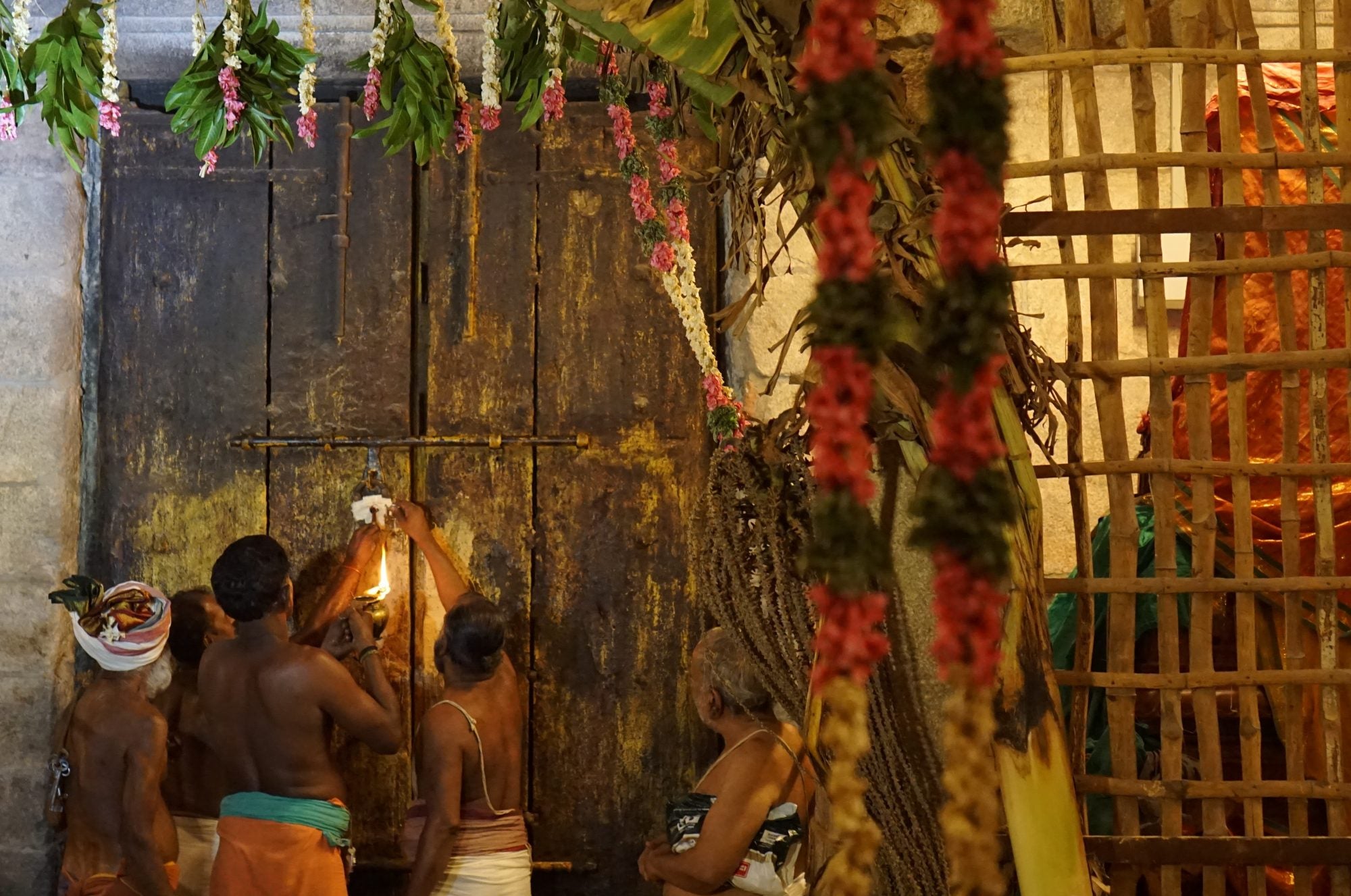On the Adhyayanotsavam
I am working on a project “Poetry Makes Worlds” on the Annual Festival of Recitation (Adhyayanotsavam). I’ve been interested in this festival ever since I read about it in Vasudha Narayanan’s Vernacular Veda almost twenty years ago. I observed the festival at the Āṇṭāḷ temple in Srivilliputtur, where it dovetails often (and in rather complicated ways) with the Nīrāṭṭa Utsavam (the festival commemorating Kōtai-Āṇṭāḷ’s) Tiruppāvai vow. At that time, my focus was really on Āṇṭāḷ, her temple, and I filed the Adhyayanotsavam at this temple in a side part of my brain. When I began my work in Alvar Tirunagari in 2007, the festival came roaring back to the forefront. Since then, the project has grown to include the entire Nava Tirupati network as well as Tirukkurungudi and Nanguneri. I am interested in all kinds of things–how space and time are managed, how poetry creates and unmakes worlds and gods, and devotees too. I am interested in the senses, and how the senses are heightened through recitation, music, percussion, scent, smell, food and the spectacle of alaṅkāra. I eventually hope to write a book about the Adhyayanotsavam, one that foregrounds poetry, feeling and experience.
*This project is supported by a fellowship from the Guggenheim Foundation for the 2018-2019 academic year*
On the Nava Tirupati
My second project is a collaborative one with a team of scholars I greatly admire. Crispin Branfoot (SOAS, London), Leslie Orr (Concordia University, Montreal), Anna Seastrand (University of Minnesota) and I are working on a network of nine Vishnu temples located along the Tamiraparani river. These temples, extolled in the poetry of Nammāḻvār, are collectively called the Nava Tirupati, but they also connect to the neighboring sites of Nanguneri (Vānamāmalai) and Tirukkurungudi. Our project is a study of how temple networks are constituted, how these temples dialog with their built environment, and the very important business of making heaven on earth. The project is interdisciplinary. Crispin Branfoot is an architectural historian of early modern south India, Leslie Orr is our inscription expert and Anna Seastrand, brings her expertise on mural painting as well as her interest in movement in temple space to the project. I work on temple festivals and the literary side of things. Our work has so far been supported by a Collaborative Grant from the American Academy of Religion and a Network Collaboration Grant from the UC Davis Humanities Institute. We’ve put these to good use–we had a joint field trip in summer 2017 and met in November 2018 to discuss future field-trips. We are planning to write a fully illustrated book on the Tirukkurungudi temple, eventually followed by one on the Nava Tirupati network.
On Female Voices and Alternative Translation Models
Ever since I first read the poetry of Kōtai-Āṇṭāḷ, I’ve been interested in the use of the female voice in āḻvār poetry. Because Kōtai is a woman, we read the female voice(s) in her poetry as contiguous with her own. But this isn’t always the case. She too adopts personae (such as the gopī-girls). This project explores the many female voices of the āḻvār-poets, with a particular emphasis on the female voices of Nammāḻvār and Tirumaṅkai, known as the Parāṅkuśa Nāyikā and Parakāla Nāyikā respectively. I do also draw attention to the particular female voices (such as those of Yaśodā and Devakī) adopted by poets like Periyāḻvār and Kulaśekaraṉ.
My primary mode of analysis and engagement with these verses is translation. These verses of intimacy and feeling also invite experiments in translations. As I have become surer of my voice as a translator, a bit more certain of the craft, I am open to taking more risks in my translating practice. I am experimenting more freely, infusing these translations with something of the lived experience of the poems and their long receptive histories.
Translations
I translate almost every day. I am currently working on two major translation projects. The first is a complete translation into English of Nammāḻvār’s Tiruvāymoḻi, which I have just completed. It is scheduled to be published by Penguin Classics in February 2020.
The Tiruvāymoḻi is 1102 verses. It’s a long, complicated, demanding poem with a long commentarial tradition attached to it. While one can read the Tiruvāymoḻi without the commentaries, to understand the poem as it has been received through the generation requires an engagement with its many, many commentaries.
My second translation project is the Sundara Kāṇdam (Fifth Book) of the Tamil Rāmāyaṇa composed by the 12th century poet, Kampaṉ. The translation is tentatively titled, Loveliness. I’ve just begun working on this long narrative book, which describes Hanumān’s leap across the ocean and his adventures in Laṅka. It’s a vivacious, vivid and gripping, and as the title (Sundara) suggests, utterly, magnificently beautiful.
